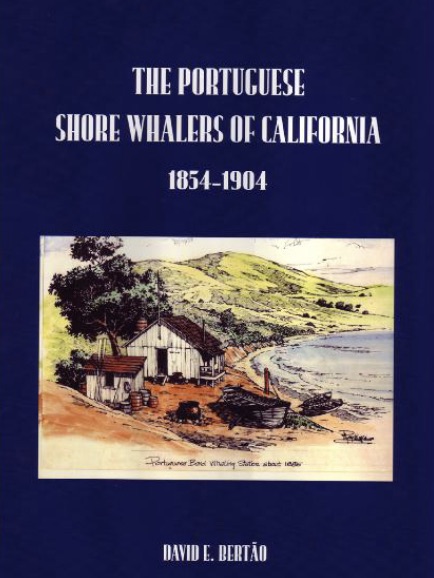|
Getting your Trinity Audio player ready...
|
RECOMMENDATION. As a Half Moon Bay Coastside History docent I am always looking for books that expand my knowledge. This book does that.
Great gift.
It costs only $15, plus $5 shipping, because it is sponsored by the Portuguese Heritage Publications of California!
By David E. Bertao
Published 2006
300 pages
9″ x 12″
Regular Price: $20.00
Special Limited Time Pricing: $15.00
Shipping and handling: $5

Pay online with PayPal or your credit card using the button below, or download the order form to arrange payment by check or money order.
Shore Whaling: A New Publication on the Portuguese Experience in California. Since Portuguese immigrants played a prominent role in the history of shore whaling in California, Portuguese Heritage Publications of California is proud to publish The Portuguese Shore Whalers of California, 1854 – 1904.
Early Whaling
The book begins with a description of the business of shore whaling in California. The second part describes the establishment and operation in California of the shore whaling companies, county by county. The final section provides a biography of known members of the various shore whaling companies.
By today’s standards, whaling is a cruel and heartless industry, pitting men and their equipment against these wonderful mammals of the sea. Yet whaling once played an important part in improving people’s standard of living in many areas of the world.
In both Europe and America, whale oil was an important fuel for household illumination and a key lubricant for industrial machinery. Whales had been hunted for over 500 years in Europe when the first colonists arrived in North America. Once here, the colonists observed Native Americans hunting whales along the Eastern Seaboard, adopted their techniques, and hired them as harpooners. Shore whaling was one of the earliest industrial endeavors of the colonists in New England.

Whaling Ships
As hunting increased and nearby whale populations declined or moved further out to sea, ever-larger vessels were employed to keep the business alive. In so doing, whalers “discovered” the sperm whale, with its superior oil for lighting and lubrication and its spermaceti for candle making. So profitable were these whales that whaling ships were deployed throughout the world’s oceans to find them. Voyages often lasted 3 to 5 years.
The Azores Connection
Many ships followed the sperm whale to the Azores, where the whales were plentiful, scurvy-fighting fruits and vegetables available for purchase, and young Azorean men willing to sign onto ships.
In spite of the immense beauty of their islands, most Azoreans lived economically difficult lives. Population pressures, the limited availability of land, and military conscription were great incentives for young men to leave. The current concentration of Americans of Portuguese descent near former whaling ports in New England, and California attest to the fact that many of these men made America their home.
California Shore Whaling
When reaching California ports, many whalemen abandoned their ships during the Gold Rush to seek their fortunes in the mines. The reality of gold mining was quite different from the dream. Many whalers subsequently abandoned the gold fields and looked for other opportunities. Some of them became shore whalers.
Once killed, whales weighing 30 tons or more had to be rowed to shore. Some sank and were lost. The blubber was stripped from the whale and cut into pieces. They were carried to large cast iron pots on higher ground. The blubber was heated until the oil separated from membranous matter. The cooled oil was stored in barrels for shipment by boat to San Francisco where it was sold.
In a good year, a typical company processed about fifteen whales. Men hoped to earn about three dollars a day. Since the actual whaling season lasted about six months, members of the whaling company had time to relax or participate in other pursuits such as agriculture.
The activity of hunting whales from land stations was repeated along the entire coast of California from Crescent City in the North to San Diego in the South. By 1879, shore whaling companies had operated from at least 27 different locations along the California coast.
A Difficult Way of Life
From the moment the whales were sighted until the day the oil was shipped to San Francisco, whaling was a strenuous and hazardous occupation. Small boats, manned by a crew of six, could be pulled many miles out to sea when attached to a harpooned whale.
Weapons were crude by 20th century standards. Harpoons with rope were thrown into the whale to attach the boat to the animal. When the boat was close enough, the whale was killed with a sharpened wide blade knife at the end of a long pole. Later, when whales became too shy to approach, guns were adopted to fire harpoons and bombs into the whale. These weapons were extremely dangerous, powder charges were high, and the recoils were tremendous. Their use was sometimes fatal – to the whaler as well as the whale.
Shore Whaling Companies
California shore whaling began in Monterey in 1854 when an American whaling captain, John Davenport, established the first shore whaling company and hired twelve Portuguese. In the following year, the Portuguese took over the business. This was the beginning of a series of companies throughout the State. Portuguese captains often went to boardinghouses in San Francisco to hire new Portuguese arrivals. This approach continued for several decades, resulting in the influx of many Portuguese immigrants into shore whaling. In fact, the Portuguese dominated the industry for half a century.
Decline of the Industry
The prices for whale oil dropped steeply as lower-cost alternatives, such as kerosene and petroleum oil, came on the market and gained favor. As the end of the 19th century approached, California farming and dairying continued to grow in importance and attracted larger numbers of Portuguese immigrants. Although agricultural workers could only expect about a dollar a day, it was a consistent, relatively safe occupation that could lead to ownership of one’s own farm. Only the old veterans continued shore whaling.
In 1904, fifty years after the business began, whalers at Monterey sold the Old Whaling Station, thereby ending the longest Portuguese shore whaling company in California.
It wasn’t until 1973 that the United States passed the Endangered Species Act, banning the use of whale products in the US.





